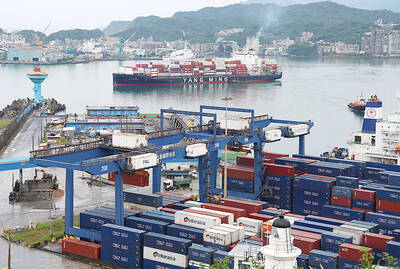Macronix International Co (旺宏電子), which supplies memory chips for Japanese video game console maker Nintendo Co, yesterday posted a loss of NT$1.66 billion (US$49.2 million) last quarter as gross margin fell to its lowest in six quarters due to low utilization and sagging demand.
Last quarter’s figures brought Macronix’s total losses last year to NT$4.19 billion, an improvement compared with losses of NT$6.45 billion in 2014. The chipmaker lost NT$949 million in the third quarter last year.
In the final quarter last year, gross margin fell to 8 percent, compared with 14 percent the previous quarter after utilization fell from 90 percent to 70 percent.
“By lowering production, we aim to bring down our inventory to a level of NT$5 billion from NT$9 billion,” company president Lu Chih-yuan (盧志遠) said.
After a long term of incurring losses, the company is likely to get out of the woods this year thanks to revenue growth and reducing manufacturing equipment depreciation costs by 67 percent to about NT$2 billion from last year’s NT$6 billion, Lu said.
“We aim to return to profit in the second half of this year,” Lu said. “We are gaining market share this year on the back of improved costs and better technological capabilities, despite not seeing any encouraging signs [of a recovery] in the macroeconomic situation.”
Macronix would eke out a monthly profit when its monthly revenue reaches NT$2 billion, Lu said.
The company expects to become the world’s top NOR Flash memory chip supplier this year, replacing Cypress Semiconductor Corp.
NOR flash memory chips are Macronix’s biggest revenue source, accounting for 62 percent of last year’s revenue of NT$20.93 billion, company data showed.
The automotive and industrial sectors would show the strongest growth for NOR flash chips this year, Lu said.
Macronix counts the world’s top 10 car brands as its customers.
The automotive and industrial sectors made up 19 percent of Macronix’s revenue last quarter and would soon rise to more than 20 percent, Lu said.
Lu said the company’s major client is developing a new platform for its video game device this year, which could provide a boost to the company’s business.
Last year, sluggish sales of video game devices resulted in an annual decline of 45 percent in revenue for the company’s ROM chip, according to company financial statement.

CHIP RACE: Three years of overbroad export controls drove foreign competitors to pursue their own AI chips, and ‘cost US taxpayers billions of dollars,’ Nvidia said China has figured out the US strategy for allowing it to buy Nvidia Corp’s H200s and is rejecting the artificial intelligence (AI) chip in favor of domestically developed semiconductors, White House AI adviser David Sacks said, citing news reports. US President Donald Trump on Monday said that he would allow shipments of Nvidia’s H200 chips to China, part of an administration effort backed by Sacks to challenge Chinese tech champions such as Huawei Technologies Co (華為) by bringing US competition to their home market. On Friday, Sacks signaled that he was uncertain about whether that approach would work. “They’re rejecting our chips,” Sacks

Taiwan’s exports soared 56 percent year-on-year to an all-time high of US$64.05 billion last month, propelled by surging global demand for artificial intelligence (AI), high-performance computing and cloud service infrastructure, the Ministry of Finance said yesterday. Department of Statistics Director-General Beatrice Tsai (蔡美娜) called the figure an unexpected upside surprise, citing a wave of technology orders from overseas customers alongside the usual year-end shopping season for technology products. Growth is likely to remain strong this month, she said, projecting a 40 percent to 45 percent expansion on an annual basis. The outperformance could prompt the Directorate-General of Budget, Accounting and

NATIONAL SECURITY: Intel’s testing of ACM tools despite US government control ‘highlights egregious gaps in US technology protection policies,’ a former official said Chipmaker Intel Corp has tested chipmaking tools this year from a toolmaker with deep roots in China and two overseas units that were targeted by US sanctions, according to two sources with direct knowledge of the matter. Intel, which fended off calls for its CEO’s resignation from US President Donald Trump in August over his alleged ties to China, got the tools from ACM Research Inc, a Fremont, California-based producer of chipmaking equipment. Two of ACM’s units, based in Shanghai and South Korea, were among a number of firms barred last year from receiving US technology over claims they have

BARRIERS: Gudeng’s chairman said it was unlikely that the US could replicate Taiwan’s science parks in Arizona, given its strict immigration policies and cultural differences Gudeng Precision Industrial Co (家登), which supplies wafer pods to the world’s major semiconductor firms, yesterday said it is in no rush to set up production in the US due to high costs. The company supplies its customers through a warehouse in Arizona jointly operated by TSS Holdings Ltd (德鑫控股), a joint holding of Gudeng and 17 Taiwanese firms in the semiconductor supply chain, including specialty plastic compounds producer Nytex Composites Co (耐特) and automated material handling system supplier Symtek Automation Asia Co (迅得). While the company has long been exploring the feasibility of setting up production in the US to address